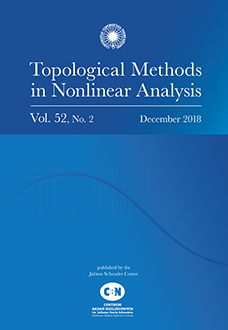Abstract
We study positive solutions to boundary value problems of the form \begin{equation*} \begin{cases} -\Delta_{p} u = \lambda \{u^{p-1-\alpha}+f(v)\} & \mbox{in } \Omega,\\ -\Delta_{q} v = \lambda \{v^{q-1-\beta}+g(u)\} & \mbox{in } \Omega,\\ u = 0=v & \mbox{on }\partial\Omega, \end{cases} \end{equation*} where $\Delta_{m}u:={\rm div}(|\nabla u|^{m-2}\nabla u)$, $m> 1$, is the $m$-Laplacian operator of $u$, $\lambda> 0$, $p,q> 1$, $\alpha\in(0,p-1)$, $\beta\in(0,q-1)$ and $\Omega$ is a bounded domain in $\mathbb{R}^{N}$, $N\geq 1$, with smooth boundary $\partial \Omega$. Here $f,g\colon [0,\infty)\rightarrow \mathbb{R}$ are nondecreasing continuous functions with $f(0)=0=g(0)$. We first establish that for $\lambda\approx 0$ there exist positive solutions bifurcating from the trivial branch $(\lambda,u\equiv 0,v\equiv 0)$ at $(0,0,0)$. We further discuss an existence result for all $\lambda > 0$ and a multiplicity result for a certain range of $\lambda$ under additional assumptions on $f$ and $g$. We employ the method of sub-super solutions to establish our results.
Citation
Ratnasingham Shivaji. Byungjae Son. "Bifurcation and multiplicity results for classes of $p,q$-Laplacian systems." Topol. Methods Nonlinear Anal. 48 (1) 103 - 114, 2016. https://doi.org/10.12775/TMNA.2016.036
Information





